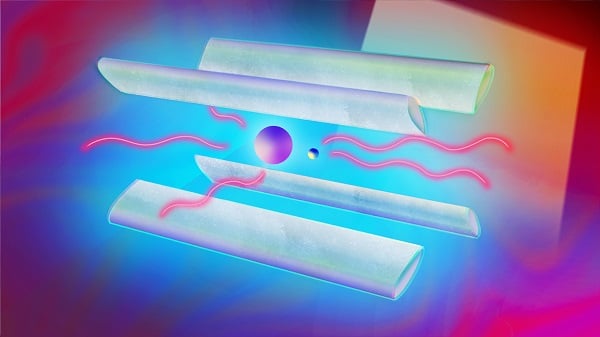Researchers at the QUEST Institute at the Physikalisch-Technische Bundesanstalt (PTB) have cooled charged ions down to 200 μK. The team combined methods — its established laser cooling of coupled ions method, and those from quantum computing — to achieve the result.
The application of quantum algorithms ensured that ions that are too dissimilar for traditional laser cooling to work effectively could be cooled together after all. According to the researchers, this is a step toward the realization of an optical atomic clock with highly charged ions that is more accurate than existing optical atomic clocks.

Mismatched partners are being cooled: A single beryllium ion (red, left) and a single highly charged argon ion (purple, right) are bombarded by lasers from various sides and are almost brought to a complete standstill. Courtesy of PTB.
The established method requires the laser cooling of precisely arranged particles; to be effective, the particles must be as similar as possible. The team uses coupled ions in the work, in which one ion, called the “cooling ion” or “logic ion,” is cooled by lasers while the other is cooled simultaneously. The cooled atom can be investigated spectroscopically, giving it the name “spectroscopy ion.”
However, the method has always reached its limits when the two ions differ too much in their charge-to-mass ratios.
To overcome this barrier, the QUEST team turned to quantum computing. Quantum algorithms are not just used to perform calculations impossible for ordinary computers; they can also help extract kinetic energy from the mismatched ion pair. During the process of so-called algorithmic cooling, quantum operations are used to transfer the energy from the barely coolable motion of the spectroscopy ion to the easily coolable motion of the logic ion.
“We were able to extract so much energy from the pair of ions — consisting of a singly charged beryllium ion and a highly charged argon ion — that their temperature finally dropped to only 200 µK,” said Lukas Spieß, a Ph.D. student at QUEST. “What is more, we also observed an unprecedentedly low level of electric-field noise.”
An atomic clock that incorporates this process could reach an uncertainty of less than 10−18, a level of performance that is only reached by the highest-performing optical atomic clocks in the world. The findings also hold implications for the development of quantum computers and precision spectroscopy.
The research was published in Physical Review X (www.doi.org/10.1103/PhysRevX.11.041049).